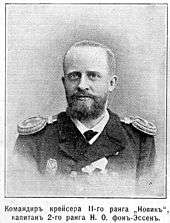Nikolai Essen
| Nikolai Essen | |
|---|---|
 Nikolai Essen | |
| Born |
11 December 1860 Saint Petersburg, Russian Empire |
| Died |
7 May 1915 (aged 54) Reval, Governorate of Estonia, Russian Empire |
| Allegiance |
|
| Service/branch |
|
| Years of service | 1880-1915 |
| Rank | Admiral |
| Commands held | Baltic Fleet |
| Battles/wars |
Russo-Japanese War World War I |
| Awards |
|
Nikolai Ottovich (von) Essen (Russian: Николай Оттович фон Эссен) (11(23) December 1860, Saint Petersburg – 7(20) May 1915, Reval) was a Russian naval commander and admiral from the Baltic German Essen family. For more than two centuries his ancestors had served in the Imperial Russian Navy, and seven had been awarded the Order of St. George, the highest military award of the Russian Empire.
Biography
Essen graduated from the Naval Cadet Corps in 1880 and after a two-year foreign cruise, attended the engineering department of the Nikolayev Naval Academy from 1883 to 1886. He was commissioned as lieutenant in 1891, and served with the Russian Pacific Fleet from 1892 to 1896, and with the Russian Mediterranean Squadron from 1897. [1]
In the early part of his career he commanded the Minesweeper no 120 (1897–98), the gunboat Grozyachiy (1898–1900), the steamship Slavianka (1901–1902) in the Black Sea. After a brief assignment as an instructor at the Naval Cadet Corps, he was appointed captain of the cruiser Novik (1902–1904), which was stationed at Vladivostok. [1]

At the start of the Russo-Japanese War, Admiral Stepan Makarov reassigned Essen to command the battleship Sevastopol at Port Arthur. After the disastrous Battle of the Yellow Sea, Essen also commanded the land-based defenses at the entrance to Port Arthur. During last weeks of the Japanese siege, he moved Sevastopol out of the relative safety of inner harbor to use her firepower to help repulse repeated Japanese attacks. However, on hearing of the surrender of Port Arthur, he moved Sevastopol into deeper water, and then scuttled her, making her the only battleship that the Imperial Japanese Navy could not raise after the war. He was sent as a prisoner of war to Japan, but was paroled after less than two months, and returned to Saint Petersburg for a hero’s welcome. For his actions, Essen was awarded the Order of St. George (3rd degree) and promoted to captain. [1]
After the end of the war Essen became the first captain of the British-built armoured cruiser Rurik. He was promoted to Rear Admiral in 1908 and appointed Commander in Chief of the Russian Baltic Fleet in 1909 when this position was created. He was promoted to Admiral in 1913. Essen, from lessons learned in the war against Japan and the mutiny of the Black Sea Fleet, urged far-reaching reforms and modernization of the Imperial Russian Navy. He recognized early the importance of submarines and aircraft, and sought to promote younger officers based on their knowledge of modern strategy and tactics, also establishing a naval training academy at Kronstadt. Above all, he pushed for operational autonomy of the Baltic Fleet.
Widely regarded as the most able of Russian admirals in World War I, Essen led the Baltic Fleet energetically during the first year of the war. His forces at the time consisted of four battleships, five cruisers, four light cruisers, 62 torpedo boats, 12 submarines and numerous smaller and specialty units. His superiors preferred but a cautious defensive position in the Baltic Sea, forcing Essen to concentrate his forces in the Gulf of Finland to protect Petrograd, with older units at the Gulf of Riga, and effectively abandoning Liepāja to the Germans. Nevertheless, on 9 August 1914 Essen led part of his fleet towards Gotland to contain the Swedish navy and deliver a note of his own making which would have violated Swedish neutrality and may have brought Sweden into the war. He was ordered back before his plan could be executed. However, on 27 August 1914, he assigned the Rurik and Pallada to commerce raiding operations in the Baltic. Although of little success, the mission went far to maintaining the morale within the Baltic Fleet.
Essen died unexpectedly after a short bout with pneumonia in May 1915. He is buried in Novodevichy Cemetery (Saint Petersburg). He was survived by his wife, Mary, and son Anton (who was later killed in action as commander of the submarine AG-14 on 24 October 1917), and two daughters who married naval officers.
Awards and commemoration
- Golden Sword for Bravery (14 March 1904)
- Order of St. George (4th class), (17 April 1905)
- Order of the White Eagle with Swords (12 December 1914)
The second ship of the Admiral Grigorovich class of frigates will be named Admiral Essen to commemorate the admiral.
| Wikimedia Commons has media related to Nikolai Essen. |
References
- Halpern, Paul G. (1994). A Naval History of World War I. London: UCL Press. ISBN 1-85728-295-7.
- Spencer C. Tucker, Who's Who in Twentieth Century Warfare, Routledge, London & New York 2001 (pg. 92) ISBN 0-415-23497-2
- Flodin, Matz (2005). Flottans underrättelsetjänst 1887-1914 (The Swedish Naval Intelligence 1887-1914). Karlskrona: Marinmuseum. ISSN 1404-0581 http://libris.kb.se/bib/10297983
- Kowner, Rotem (2006). Historical Dictionary of the Russo-Japanese War. ISBN 0-8108-4927-5: The Scarecrow Press.